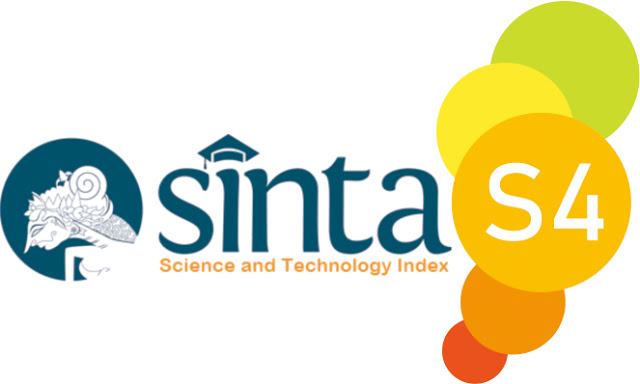Application of Ensemble Machine Learning Methods for Aspect-Based Sentiment Analysis on User Reviews of the Wondr by BNI App
Abstract
This study analyzes user perceptions of the Wondr by BNI app using Aspect-Based Sentiment Analysis (ABSA) and a stacking ensemble learning approach on user reviews. Data were collected from the Google Play Store and App Store through scraping, then processed and labeled. The study involves two classification stages: aspect identification and sentiment classification for each aspect. The stacking ensemble model without resampling showed the best performance, with F1-scores of 99.4% for UI (User Interface), 99.3% for Authentication, and 99% for Transaction. For sentiment classification, F1-scores reached 82.2% User Interface (UI), 87.8% (Authentication), and 92.4% (Transaction). The use of LIME (Local Interpretable Model-Agnostic Explanations) improved model interpretability by highlighting keywords influencing the classification results. The final output of this research is a website capable of performing aspect-based sentiment classification
Downloads
References
M. Khoirul, U. Hayati, and O. Nurdiawan, “Analisis Sentimen Aplikasi Brimo Pada Ulasan Pengguna Di Google Play Menggunakan Algoritma Naive Bayes,” 2023.
J. Iqbal and Isroq Urrahmah, “Pengaruh Kemudahan Dan Ketersediaan Fitur Terhadap Penggunaan Mobile Banking,” 2021.
Susi Setiawati, “Cashless Makin Digemari, Ini 5 Digital Banking Pilihan Warga RI,” CNBC Indonesia, Jun.10,2024.https://www.cnbcindonesia.com/research/20240610063016-128-545113/cashless-makin-digemari-ini-5-digital-banking-pilihan-warga-ri (accessed Dec. 29, 2024).
PT. Bank BNI, "Wondr by BNI." 2024. [Online]. Available: https://wondr.bni.co.id/. (Accessed: Dec. 29, 2024).
Zefanya Aprilia, “Pengguna wondr Tembus 2 Juta, DPK BNI (BBNI) Bakal Meroket,” CNBC Indonesia,Oct.11,2024.https://www.cnbcindonesia.com/market/20241011105508-17-578794/pengguna-uwondr-tembus-2-juta-dpk-bni--bbni--bakal-meroket (accessed Dec. 29, 2024).
S. Fransiska, Rianto, and A. Irham Gufroni, “Sentiment Analysis Provider by.U on Google Play Store Reviews with TF-IDF and Support Vector Machine (SVM) Method,” Sci. J. Informatics, vol. 7, no. 2, pp. 2407–7658, 2020, [Online]. Available: http://journal.unnes.ac.id/nju/index.php/sji
A. Chandra Saputra, P. Raya Jln Hendrik Timang, P. Raya, P. Studi Teknik Informatika, F. Teknik, and U. Palangka Raya Jln Hendrik Timang, “Klasifikasi Rating Aplikasi Android Di Google Play Store Menggunakan Algoritma Gradient Boost Agus Sehatman Saragih, 2022 .
N. B. Sidauruk, N. Riza, R. Nuraini, and S. Fatonah, “Penggunaan Metode SVM Dan Random Forest Untuk Analisis Sentimen Ulasan Pengguna Terhadap KAI Access Di Google Playstore,” 2023.
S. Amien, P. Perdana, T. Bharata Aji, and R. Ferdiana, “Aspect Category Classification dengan Pendekatan Machine Learning Menggunakan Dataset Bahasa Indonesia (Aspect Category Classification with Machine Learning Approach Using Indonesian Language Dataset),” 2021.
A. Patel, P. Oza, and S. Agrawal, "Sentiment analysis of customer feedback and reviews for airline services using language representation model," *Procedia Computer Science*, vol. 218, pp. 2459–2467, 2023. [Online]. Available: https://doi.org/10.1016/J.PROCS.2023.01.221
W. S. Dharmawan, “I N F O R M A T I K A Dalam Prediksi Penyakit Jantung,” Jurnal Informatika, Manajemen dan Komputer, vol. 13, no. 2, 2021.
Y. Pristyanto, "Penerapan Metode Ensemble untuk Meningkatkan Kinerja Algoritme Klasifikasi pada Imbalanced Dataset," 2019. [Online]. Available: https://archive.ics.uci.edu/ml/datasets/User+Knowledge
A. K. Putri and H. Suparwito, “Uji Algoritma Stacking Ensemble Classifier pada Kemampuan Adaptasi Mahasiswa Baru dalam Pembelajaran Online,” 2023.
L. Maretva Cendani and A. Wibowo, “Perbandingan Metode Ensemble Learning pada Klasifikasi Penyakit Diabetes,” 2022.
S. George and D. Srividhya, “Aspect Based Sentiment Analysis of Restaurant Reviews using Ensemble Algorithms,” 2021.
R. Kalule, H. A. Abderrahmane, W. Alameri, and M. Sassi, “Stacked ensemble machine learning for porosity and absolute permeability prediction of carbonate rock plugs,” Sci Rep, vol. 13, no. 1, Dec. 2023, doi: 10.1038/s41598-023-36096-2.
Z. An, T. Xiong, Z. Zou, and H. Wan, “Aspect-based Sentiment Analysis with an Ensemble Learning Framework for Requirements Elicitation from App Reviews,” Journal of Internet Technology, vol. 25, no. 7, pp. 1083–1090, Dec. 2024, doi: 10.70003/160792642024122507012.
J. Khatib Sulaiman, N. Rizky Nuraeda, M. Liebenlito, and T. Edy Sutanto, “Explainable Sentiment Analysis pada Ulasan Aplikasi Shopee Menggunakan Local Interpretable Model-agnostic Explanations,” Indonesian Journal of Computer Science.
A. Munna, E. Zuliarso, U. Stikubank Jl Trilomba Juang No, and R. Artikel, “Interpretasi model Stacking Ensemble untuk analisis sentimen ulasan aplikasi pinjaman online menggunakan LIME,” AITI: Jurnal Teknologi Informasi, vol. 21, no. 2, pp. 183–196, 2024.
P. Arsi and R. Waluyo, "Analisis Sentimen Wacana Pemindahan Ibu Kota Indonesia Menggunakan Algoritma Support Vector Machine (SVM)," vol. 8, no. 1, pp. 147–156, 2021, doi: 10.25126/jtiik.202183944.
Pavithra and Savitha, “Topic Modeling for Evolving Textual Data Using LDA, HDP, NMF, BERTOPIC, and DTM With a Focus on Research Papers,” Journal of Technology and Informatics (JoTI), vol. 5, no. 2, pp. 53–63, Apr. 2024, doi: 10.37802/joti.v5i2.618.
Aishwarya Bhangale, “Introduction to Topic Modelling with LDA, NMF, Top2Vec and BERTopic,” Medium, Mar. 08, 2023. https://medium.com/blend360/introduction-to-topic-modelling-with-lda-nmf-top2vec-and-bertopic-ffc3624d44e4 (accessed Jan. 07, 2025).
A. Sanjaya, A. Bagus Setiawan, U. Mahdiyah, I. Nur Farida, A. Risky Prasetyo, and U. Nusantara PGRI Kediri, "Pengukuran Kemiripan Makna Menggunakan Cosine Similarity dan Basis Data Sinonim Kata Measurement of Meaning Similarity Using Cosine Similarity and Word Synonyms Database," vol. 10, no. 4, 2023, doi: 10.25126/jtiik.2023106864.
A. Bandhakavi, N. Wiratunga, S. Massie, and R. Luhar, “Context extraction for aspect-based sentiment analytics: combining syntactic, lexical and sentiment knowledge.” [Online]. Available: https://www.sentisum.com/, 2018.
R. Nurhidayat and K. E. Dewi, "Komputa: Jurnal Ilmiah Komputer dan Informatika Penerapan Algoritma K-Nearest Neighbor dan Fitur Ekstraksi N-Gram dalam Analisis Sentimen Berbasis Aspek," vol. 12, no. 1, 2023.
J. Khatib Sulaiman, N. Rizky Nuraeda, M. Liebenlito, and T. Edy Sutanto, “Explainable Sentiment Analysis pada Ulasan Aplikasi Shopee Menggunakan Local Interpretable Model-agnostic Explanations,” Indonesian Journal of Computer Science.
A. Munna, E. Zuliarso, U. Stikubank Jl Trilomba Juang No, and R. Artikel, “Interpretasi model Stacking Ensemble untuk analisis sentimen ulasan aplikasi pinjaman online menggunakan LIME,” AITI: Jurnal Teknologi Informasi, vol. 21, no. 2, pp. 183–196, 2024.
Copyright (c) 2025 Rendi Hardiartama, Amalia Anjani Arifiyanti, Seftin Fitri Ana Wati3

This work is licensed under a Creative Commons Attribution-ShareAlike 4.0 International License.
This is an open-access article distributed under the terms of the Creative Commons Attribution-ShareAlike 4.0 International License which permits unrestricted use, distribution, and reproduction in any medium. Users are allowed to read, download, copy, distribute, search, or link to full-text articles in this journal without asking by giving appropriate credit, provide a link to the license, and indicate if changes were made. All of the remix, transform, or build upon the material must distribute the contributions under the same license as the original.















